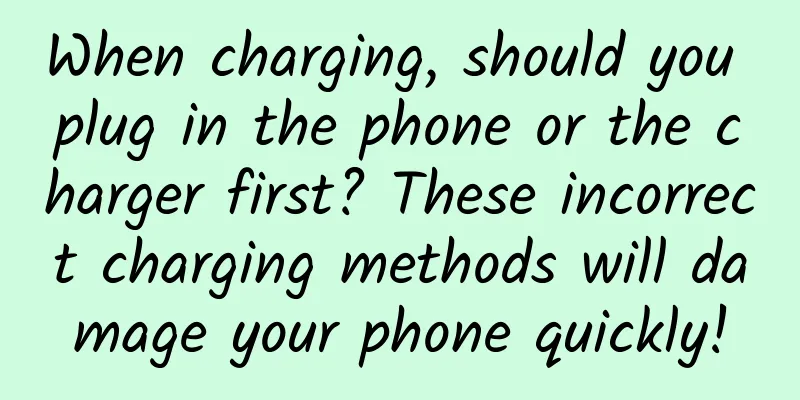When charging, should you plug in the phone or the charger first? These incorrect charging methods will damage your phone quickly!

|
How much battery is left in a mobile phone is a matter of life and death for many people in modern society. The strong demand for mobile phone charging has also spawned many gimmicks on the market: wireless charging, double-speed charging, and high-energy power banks that can be used for a week. There are so many options, but what is the correct way to charge a mobile phone? 01 Does the mobile phone have to be fully charged? There are always some sayings about charging: charge your phone only when it runs out of power, and fully charge it every time, so that it is beneficial to battery maintenance, and charging at any time will affect the battery life. In fact, these theories are outdated. Rechargeable batteries that were widely used in the early years, such as nickel-cadmium batteries, are mainly made of nickel hydroxide and metal cadmium, and their disadvantages are obvious: they have a memory effect. In simple terms, when the battery is not fully charged or exhausted for many times, the battery capacity will "remember" the amount of power during charging and power failure, and regard them as the maximum and minimum values of power respectively, resulting in a decrease in battery capacity. However, nickel-cadmium batteries and other batteries have been gradually phased out due to heavy metal pollution, high weight, and low energy density, and have been replaced by lithium-ion batteries. Smart phones mostly use lithium-ion batteries. Compared with nickel-cadmium batteries, its advantages include: high energy density, which means that it can store more electricity in the same volume or weight; weak memory effect, so even if you unplug it before it is fully charged, it will not have any effect. The precautions for lithium-ion batteries are exactly the opposite of those for nickel-cadmium batteries: do not charge when it is out of power, do not overcharge it, and do not need to charge and discharge deeply every time . The life of a lithium-ion battery is related to the charging cycle. Every time 100% of the power is used, a cycle is completed. The more cycles, the more obvious the reduction in battery life. A study on 11 types of lithium ions showed that after 250 cycles, the battery capacity will be significantly attenuated. After 300 to 500 cycles, the battery capacity will drop to 80% of the original capacity. What is the principle? According to data, when lithium-ion batteries are deeply charged and discharged, the material structure of the positive and negative electrodes will be destroyed. Lithium-ion batteries mainly rely on the movement of lithium ions between the positive and negative electrodes to work. Once the space for their movement becomes smaller, the battery capacity will also decrease accordingly. Therefore, compared to "full charging and discharging", "multiple small charges" is more suitable for current mobile phone charging habits . In addition to the power before and after charging, another issue that is easily overlooked also affects the battery life. 02 Should I plug in the phone or the charger first? Should I plug the plug into the power supply first and then connect it to the mobile phone with the data cable, or should I connect the data cable to the mobile phone first and then plug the plug into the power supply? The answer is: the former. They are all charging, so what impact will such subtle differences have? Here is a point of knowledge: the voltage of electricity used by Chinese residents is 220V, but the voltage of mobile phone chargers is often within 5V. When charging a mobile phone, the charger will convert the high-voltage current into low-voltage direct current through a transformer and then transmit it to the mobile phone. At this time, if the charger is connected to the mobile phone and then plugged into the power supply, the charger may lose its self-regulation ability, thereby outputting surge voltage . Surge, also known as surge, refers to a momentary overvoltage that exceeds the normal working voltage. Sometimes the bright sparks you see when plugging in and out of a switch are mostly surges. Although it only lasts for a millionth of a second, it can cause considerable damage to the mobile phone battery over time. If you plug in the charger first and then connect the phone, this situation will hardly happen. Unless the current itself is unstable. After charging, should I unplug the phone or the plug first? The answer is: unplug the phone first. Because when you unplug the charger, a reverse instantaneous current will also be generated, which will accelerate the aging of the battery. The principle seems complicated, but it is not difficult to remember the correct order of plugging and unplugging. You can try to treat the charger, charging cable and socket as one. When charging, the phone is "attached" and when it is fully charged, the phone is "abandoned". This operation is much safer . 03 Pay attention to charging the power bank Many people carry a power bank with them in case they can't find an outlet when they are out. It is indeed very convenient. A small mobile power bank can maintain the normal operation of the mobile phone. It is simply a lifesaver. But there are also many gimmicks and misunderstandings about power banks. At present, there are many power banks on the market that claim to have a capacity of 20,000 mAh. You should know that most mobile phones, even the flagship version, have a battery capacity of less than 5,000 mAh. The "nail house" products in the early years even had a pitiful 2,000 to 3,000 mAh. If you buy a 20,000 mAh power bank, wouldn't it mean that a family of three can travel for two days without worrying? When you really buy it, you will find that it will run out of power after charging twice. Is it a false advertisement by the merchant? In fact, they are playing a word game. The capacity marked by merchants is mostly the capacity of the battery cell itself, that is, the sum of the power of multiple lithium-ion batteries in the battery. Due to power loss during the conversion process, the effective power that the power bank can provide to the mobile phone is definitely lower than this data. If you want to know how many times a power bank can actually be used, you need to carefully read the small print in the manual: rated capacity. This is the minimum discharge capacity tested in the laboratory . A media outlet once conducted an evaluation and found that the actual capacity of power banks that claim to have a capacity of 20,000 mAh can differ by as much as 4,000 mAh, which is enough to fully charge most mobile phones. When using a power bank, please also note: Since the power bank also uses lithium-ion batteries, its lifespan is also affected by the charging cycle. It is best not to charge the power bank for a long time. 04 How to charge correctly? If the use of mobile phones also has a shortcoming, the battery life is probably that shortcoming. However, in daily use, there are some charging methods that you think are correct, but in fact they are not. 1. Can’t use charging cables and chargers interchangeably? It is customary to give a charging device when buying a mobile phone, but in recent years, some manufacturers have stopped giving away chargers in the name of environmental protection, so you have to buy them yourself. The prices on the official website are too high, so many people will choose cheaper ones, thinking that charging devices themselves are consumables. If you don't keep an eye on the cat at home, the charging cable will be bitten and become unusable. This also leads to many people using the charging cable, charger and mobile phone for a short time, and perhaps the charging cable, charger and mobile phone are no longer a complete set. As a result, many rumors came out: an incompatible charger will cause the battery to short circuit and shorten its service life. In fact, this statement obviously underestimates the charger. The charger usually has a smart chip inside to identify the current and voltage required by the phone and adjust it accordingly . For example, if you buy a fast charging head, but the phone does not support fast charging, the fast charging head will automatically adjust to the input power suitable for the phone. Some people complain that the fast charging head does not work, and this is actually the principle. However, when purchasing, try to identify regular brands and don't be tempted to buy counterfeit products . After all, it is hard to say what the configuration of counterfeit chargers is. It is very likely that they will not be able to identify the current and voltage required by the mobile phone and damage the phone. 2. Don’t charge while playing? Some people think that discharging and charging the battery at the same time will affect the battery life. In fact, what really affects the battery life is the sudden temperature rise caused by charging while playing games. Everyone has this experience. When playing high-configuration games or using fast charging, the phone will get hot. A survey shows that even if the phone is not in use, the temperature rise will still accelerate the reduction of battery capacity. Therefore, for the sake of battery safety, it is best not to let it "multitask" . In addition, it is important to note that you should not buy a protective case that is too thick for your phone. There are many fancy protective cases on the market, which look good, but not all of them are suitable for mobile phones. Like computers and other devices, mobile phones also need heat dissipation. If you wrap it tightly and use heat-insulating materials, it will only make the phone look like there are no scratches on the outside, but the inside will already be damaged. To avoid high temperatures, also be careful not to place your phone next to your pillow or in the sun before going to bed. This action protects not only your phone, but also you . References: [1]Bergveld, HJ; Kruijt, WS; Notten, Peter HL (2002-09-30). Battery Management Systems: Design by Modelling. Springer. pp. 38–. ISBN 9781402008320. Retrieved 5 June 2013. [2]"Voltage Depression ("Memory Effect")". Duracell.com. Procter & Gamble. Archived from the original on March 3, 2009. Retrieved September 15, 2015. [3]Battery University. (2021). BU-802: What causes capacity loss?[4]Understanding memory effect in Lithium-ion batteries retrieve fromhttps://evreporter.com/understanding-memory-effect-in-lithium-ion-batteries/ Author: Li Mi Popular Science Author Reviewer: Zhou Xiaoliang, Senior Engineer, Physics Laboratory, Beijing Jiaotong University |
<<: Did you know? Protecting dental health should start from primary and secondary school students!
Recommend
Santonban and Yuanqi Forest’s popular online brand methods
01Best sellers require new technologies Technolog...
[Case] With the right copywriting, CTR increased 6.3 times!
As the saying goes: Creativity comes from inspira...
Find inner peace with 1 minute of quiet piano music
Find inner peace in 1 minute with the sound of th...
Li Jianyu 7-day singing bowl body and mind healing course singing bowl music purifies energy micro-course video + audio course
Li Jianyu's 7-day singing bowl body and mind ...
The development history of CRISPR/Cas9 technology: it set off a genetic revolution as soon as it appeared
Introduction In the last issue, we mainly talked ...
Bao Juncheng: ATA All-round Literacy - Reading Chinese Stories (A)
A unique learning dimension: explaining Chinese s...
Moving forward on the Android road
Counting the days, from graduation to now, I have...
Detailed explanation of the seven versions of Win10: What are the main differences?
Microsoft's much-anticipated next-generation ...
A new app marketing plan
How to promote a new App? Nowadays, App promotion...
In addition to Google, they are also developing driverless technology
At Google's I/O Global Developer Conference, ...
How to deal with the crash of enterprise server hosting system?
In early July, FileBlaze, headquartered in San Fr...
The latest research found that comets from outside the solar system originally ran away from the solar system!
Comets from outside the solar system, some of the...
The less bad cholesterol, the better, and the more good cholesterol, the better? In fact, this range is more appropriate!
With the popularization of health knowledge, many...
From driving a tank to driving a spaceship, will the Shenzhou-17 astronauts drive to the moon in the future?
At 11:14 on October 26, 2023, at the Jiuquan Sate...









